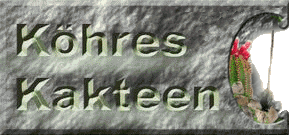|
Aussaatanleitung Kakteen und Sukkulenten
Zur Keimung von Kakteensamen sind drei Bedingungen erforderlich: Licht, Wärme und Feuchtigkeit.
Wir benutzen für alle Aussaaten ein Torf-Sand gemisch und haben damit die besten Keimergebnisse erzielt. Kakteen sind Lichtkeimer und benötigen zur Keimung etwas Helligkeit, aber keine direkte Sonneneinstrahlung. In den ersten 4-8 Wochen wird der Aussaatbehälter stark mit Papier abgedunkelt, so dass ein diffuses Licht entsteht, dies vermindert auch gleichzeitig die Algenbildung. Der günstigste Temperaturbereich liegt zwischen 15°C und 35°C. Einige Sorten gelten als Frostkeimer, besonders verschiedene amerik. Sorten und Hochandine, sowie div. Opuntien. In der Zeitschrift der Deutschen Kakteengesellschaft sind schon viele Abhandlungen erschienen, die sich mit Keimproblemen von schwierigen Sorten befassen. Um schädliche Pilze zu vermindern ist eine Temperatur über 25°C günstig, nachts können Werte kurzzeitig absinken.
Chinosol hat sich bei verschiedenen Samen als ausgesprochen keimhemmend erwiesen und sollte für die Aussaat nicht verwendet werden, für späteren Pilzbefall hat sich Malvin (Wirkstoff Captan) bewährt. In den ersten zwei Wochen sollte die Oberfläche gut feucht, aber nicht nass sein. Auf alle Fälle sollte man ein Austrocknen der Oberfläche vermeiden. Ich halte meine Aussaaten mindestens 4 Wochen verschlossen, wodurch ein Algen- und Pilzbefall von außen sowie ein Austrocknen vermieden wird. Tägliche Kontrolle ist in den ersten 4 Wochen notwendig. Die Bewässerung wird von unten vorgenommen, um ein Verschlämmen und späteres Verkrusten der Oberfläche zu verhindern. Das Substrat sollte eine durchlässige Mischung sein, das man in einem Einwegglas keimfrei dämpft. Ich verwende seit Jahren mit Erfolg feingesiebten Bimskies, der gut feucht zuhalten ist, damit keine stauende Nässe auftritt. Auch fein ausgesiebte Blumenaussaaterde mit ca. 10% Sand kann für die Aussaat Verwendung finden. Später kann zu einer Weiterkultur in ein anderes Substrat pikiert werden. Der Samen wird auf das Substrat aufgestreut und leicht angedrückt, auf keinen Fall aber bedeckt, was die Keimung verhindern oder verzögern kann. Man streut den Samen so dicht aus, dass ein Zwischenraum der 2-3 fachen Samenstärke entsteht. Die Mehrzahl der Samen sollte innerhalb der ersten 2 Wochen keimen. Manche Sorten keimen schon nach zwei bis drei Tagen, andere benötigen eine längere Keimzeit. Besonders Mammillarien keimen in Schüben mit längeren Zwischenräumen. Frische Samen von meist großblütigen Mammillarien wie M. goldii, M. haudeana, M. luethyi, M. theresae, M. saboe haben eine Keimsperre. Keimen die Samen bei dem ersten Versuch nicht, sollte man später erneute Keimversuche machen, eine sichere Methode zur Keimung dieser Samen ist noch nicht gefunden. Einige sukkulente Samen sollten gut abgedeckt werden oder unter schwarzer Folie wie Dunkelkeimer behandelt werden. Die Aussaat von Anacampseros, Conophytum, Echeveria, Crassulacea, Lithops und Mesembryanthemum sollte bis zum keimen nicht über 20°C gehalten und nicht abgedeckt werden. Dinteranthus benötigt bis zu 3 Monaten zum Keimen. Tillandsien werden am besten auf ein Kunststoffgewebe ausgelegt und mindestens 2x am Tag mit weichem Wasser besprüht. Nach ca. 2 Wochen kann man die Samen mit einem Volldünger düngen (ca. 0,01%). Für Euphorbien und andere Sukkulenten gilt das gleiche wie oben, jedoch sollten sie nach dem Keimen mehr Luft und Licht haben. Palmen, Dracaena, Asperagus, Sophora und Musa müssen von ihrem Fruchtfleisch gereinigt werden. Danach lässt man sie in ca. 25°C warmen Wasser quellen. Die Samen werden dann in ein Torf-Sandgemisch ausgelegt und in der gleichen Höhe wie die Samen dick sind mit Substrat abgedeckt. Pachypodium benötigen zum Keimen ca. 25–30°C und eine sehr hohe Luftfeuchtigkeit. Cissus und Testudinaria keimen am besten an den kurzen Tagen bei 25-30°C oder werden bis zum Keimen mit schwarzer Folie abgedeckt und brauchen viel Feuchtigkeit. Nepenthes werden auf Torf ausgesät, die Keimung dauert 6-8 Wochen.
Ich hoffe Ihnen hiermit ein paar Tipps gegeben zu haben und wünsche Ihnen viel Erfolg und Freude bei der Aussaat.
Gerhard Köhres
Aussahtanleitungen Zwiebeln:
|



